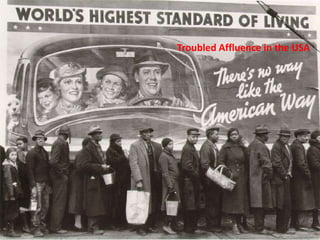
Civil Rights in the USA
- 1. Troubled Affluence in the USA
- 2. Despite the Economic Boom, deep seated problems remained in US Society.
- 3. Racial Conflict ◦ Case Study: The Montgomery Bus Boycott Urban Poverty Crime and Drugs
- 4. Declaration of Independence: “All men are created equal” US Constitution: "no state shall . . . deny to any person within its jurisdiction the equal protection of the laws.“
- 5. Who am I? What did I do?
- 6. The Jim Crow Laws: Passed after the abolition of slavery in the Southern US States Premise: To prevent “race mixing” by providing “separate but equal” facilities for people of different races. What would be the problem?
- 9. Blacks were urbanised – easier to organise Blacks were more educated USA – “Leader of the Free World” (?) Mass Media – TV Role of Churches and Clergymen – E.G. MLK Rise of liberal ideas
- 20. The Problem we all live with depicts 6 Year Old Ruby Bridges who was escorted by federal marshals to school after desegregation What elements has the artist used to show the hostility faced by Bridges?
- 22. This picture was taken in 1941… what does “carry[ing] guns for Uncle Sam” mean?
- 29. End of Segregation in the Army Civil Rights Acts – 1957 and 1964 Voting Rights Act 1965 Affirmative Action – aka “positive discrimination”
- 31. Baptist Preacher in Montgomery, Alabama Organised Montgomery Bus Boycott Organised further boycotts which provoked a “white backlash” – media coverage Awarded Nobel Peace Prize His efforts led to the passing of the Civil Rights Act, 1964 and Voting Rights Act 1965 Eventually overtaken by more militant Civil Rights Activists such as Malcolm X Also campaigned on social and economic issues Assassinated in 1968
- 37. Despite strong opposition to equality for Blacks in the Southern US States, most Americans agreed with the Civil Rights Movement US Government granted many civil rights to blacks – overruling individual states objections Pres Kennedy and Johnson – supported civil rights movement Some later Presidents (e.g. Reagan) took a hands off approach and emphasised role of state government Genie out of bottle though!
- 38. USA prided itself on being the richest country in the world (still is) But Poverty was a major problem – country very rich on one (generally white) hand, very poor on another (black) As Blacks became more urbanised, they ended up with the worst housing in the cities – ghettos Whites fled to the suburbs Decline of manufacturing – blacks ended up with worst jobs
- 39. More poor people in cities = less tax collected in cities Meant cities became “run down” New housing developments – tower blocks (like Ballymun in Dublin) meant poverty became worse Drug dealing, crime increased.
- 40. From the 1940s onwards US Governments had brought in anti poverty measures ◦ Increasing welfare ◦ Established minimum wage ◦ Increased training opportunities However President Johnson (1963-68) increased Govt action against poverty – his policies became known as the “War on Poverty”
- 41. “Great Society” was Johnson’s term for his anti-poverty programme ◦ Established a “Poverty Line” ◦ Set up Office of Economic Opportunity ◦ Increased funding given to public schools ◦ New housing & rent aid for low income people ◦ Set up health programmes known as Medicare (elderly support) and Medicaid (for poor people) However the rising tide of optimism was stopped by the Watts Riots and by the escalating problem of the War in Vietnam
- 43. A cocktail of discrimination, unemployment, rising expectations, the availability of new drugs and the ready availability of guns meant that crime levels rose rapidly after World War 2 The opinion grew that Johnson and his Democratic Party were “soft on crime” Democrats lost most of the elections from 1968 onwards because of this and other issues Most criminals were Black, male and poor – factors that led to slowdown in efforts to tackle racism
- 45. http://www.newstalk.ie/programmes/all/talking- history/ Available free on itunes or download direct from the website.
